Do you have a question about the Subaru 1998 Forester and is the answer not in the manual?
Information on operating keys, locks, power windows, rear gate, fuel filler, engine hood, and roof rails.
Details on seat adjustment, seat belt usage, child restraint systems, and SRS AIRBAG system operation.
Overview of the instrument panel, gauges, warning lights, and various controls for vehicle operation.
Information on the ventilation system, heating, air conditioning, and operating tips for climate control.
Guide to operating the radio, cassette player, and understanding audio system features and settings.
Details on interior features like sun visors, storage compartments, lighting, and cup holders.
Instructions for vehicle break-in, fuel requirements, starting/stopping the engine, driving, and trailer towing.
Procedures for handling emergencies like overheating, flat tires, jump starting, and towing the vehicle.
Guidelines for exterior and interior cleaning, waxing, polishing, and corrosion protection for the vehicle.
Information on routine maintenance, fluid checks, filter replacement, and basic service procedures.
Technical data including dimensions, engine, electrical system, capacities, tires, and fuses.
Details on uniform tire quality grading standards and procedures for reporting safety defects.
Essential safety advice for driving, covering seat belts, airbags, child safety, and hazardous substances.
Instructions for locking and unlocking doors from outside and inside, including child safety locks.
Details on operating power windows, including safety precautions and switch functions.
Adjustments for front seats including fore/aft, reclining, height, lumbar support, and seat heaters.
Details on reclining, folding down seatbacks, and headrest adjustments for rear seats.
Instructions on fastening, unfastening, and safety tips for 3-point seat belts.
Information on fastening and unfastening 2-point lap belts and related safety advice.
Guidelines for installing child restraint systems, including precautions for airbags and seat positions.
Explanation of the Supplemental Restraint System (SRS) AIRBAG, its operation, and safety precautions.
Diagram identifying major controls and indicators on the vehicle's instrument panel.
Explanation of the speedometer, tachometer, fuel gauge, and warning lights in the combination meter.
Details on the speedometer, odometer/trip meter, tachometer, fuel gauge, and temperature gauge.
Descriptions of various warning and indicator lights and their meanings.
Procedures for starting the engine in manual and automatic transmission vehicles, including cold weather tips.
Guide to setting, canceling, and changing cruise control speed, with safety warnings.
Advice on brake operation, including wet brakes, engine braking, tire punctures, and brake system components.
Information on ABS operation, self-checking, warning light, and driving precautions.
Comprehensive guide to towing trailers, including equipment, operation, and warranty information.
Procedures for handling engine overheating, including checking coolant and dealing with steam.
Detailed steps and safety precautions for jump starting a vehicle with a discharged battery.
Guidance on changing a flat tire, including safety warnings for using the jack and tools.
General procedures for towing the vehicle, including flat-bed transport and wheel-raised towing.
Instructions for checking engine oil level, changing oil/filter, and recommended grades/viscosities.
Procedures for checking and changing engine coolant, with safety warnings about hot coolant.
Information on platinum-tipped spark plugs, their replacement, and recommended types.
Instructions for checking manual transmission oil level and recommended grade/viscosity.
Procedures for checking automatic transmission fluid level (hot/cold) and recommended fluid types.
Instructions for checking front differential gear oil level and recommended grade/viscosity.
Guidance on checking rear differential gear oil level and recommended grade/viscosity.
Procedures for checking power steering fluid level (hot/cold) and recommended fluid types.
Instructions for checking brake fluid level and recommended fluid types, with safety warnings.
Guidelines for checking clutch fluid level and recommended fluid types, with safety and usage precautions.
Safety precautions for working with the battery and instructions for checking fluid level.
Information on audible brake pad wear indicators and breaking-in new brake pads.
Advice on tire inspection, rotation, pressure checking, adjusting, and aluminum wheel care.
Step-by-step guide for replacing fuses located behind the coin tray.
Guide to replacing various vehicle bulbs, including wattage and bulb numbers.
General vehicle specifications including dimensions, engine, electrical system, and capacities.
Engine model, type, displacement, bore, stroke, compression ratio, and firing order.
Details on battery type, reserve capacity, amperage, alternator, and spark plugs.
Fluid capacities for fuel tank, engine oil, transmission oil, and coolant.
Information on tire type, size, pressure, and trailer towing tire specifications.
Explanation of tire grading standards for treadwear, traction, and temperature resistance.
Information on operating keys, locks, power windows, rear gate, fuel filler, engine hood, and roof rails.
Details on seat adjustment, seat belt usage, child restraint systems, and SRS AIRBAG system operation.
Overview of the instrument panel, gauges, warning lights, and various controls for vehicle operation.
Information on the ventilation system, heating, air conditioning, and operating tips for climate control.
Guide to operating the radio, cassette player, and understanding audio system features and settings.
Details on interior features like sun visors, storage compartments, lighting, and cup holders.
Instructions for vehicle break-in, fuel requirements, starting/stopping the engine, driving, and trailer towing.
Procedures for handling emergencies like overheating, flat tires, jump starting, and towing the vehicle.
Guidelines for exterior and interior cleaning, waxing, polishing, and corrosion protection for the vehicle.
Information on routine maintenance, fluid checks, filter replacement, and basic service procedures.
Technical data including dimensions, engine, electrical system, capacities, tires, and fuses.
Details on uniform tire quality grading standards and procedures for reporting safety defects.
Essential safety advice for driving, covering seat belts, airbags, child safety, and hazardous substances.
Instructions for locking and unlocking doors from outside and inside, including child safety locks.
Details on operating power windows, including safety precautions and switch functions.
Adjustments for front seats including fore/aft, reclining, height, lumbar support, and seat heaters.
Details on reclining, folding down seatbacks, and headrest adjustments for rear seats.
Instructions on fastening, unfastening, and safety tips for 3-point seat belts.
Information on fastening and unfastening 2-point lap belts and related safety advice.
Guidelines for installing child restraint systems, including precautions for airbags and seat positions.
Explanation of the Supplemental Restraint System (SRS) AIRBAG, its operation, and safety precautions.
Diagram identifying major controls and indicators on the vehicle's instrument panel.
Explanation of the speedometer, tachometer, fuel gauge, and warning lights in the combination meter.
Details on the speedometer, odometer/trip meter, tachometer, fuel gauge, and temperature gauge.
Descriptions of various warning and indicator lights and their meanings.
Procedures for starting the engine in manual and automatic transmission vehicles, including cold weather tips.
Guide to setting, canceling, and changing cruise control speed, with safety warnings.
Advice on brake operation, including wet brakes, engine braking, tire punctures, and brake system components.
Information on ABS operation, self-checking, warning light, and driving precautions.
Comprehensive guide to towing trailers, including equipment, operation, and warranty information.
Procedures for handling engine overheating, including checking coolant and dealing with steam.
Detailed steps and safety precautions for jump starting a vehicle with a discharged battery.
Guidance on changing a flat tire, including safety warnings for using the jack and tools.
General procedures for towing the vehicle, including flat-bed transport and wheel-raised towing.
Instructions for checking engine oil level, changing oil/filter, and recommended grades/viscosities.
Procedures for checking and changing engine coolant, with safety warnings about hot coolant.
Information on platinum-tipped spark plugs, their replacement, and recommended types.
Instructions for checking manual transmission oil level and recommended grade/viscosity.
Procedures for checking automatic transmission fluid level (hot/cold) and recommended fluid types.
Instructions for checking front differential gear oil level and recommended grade/viscosity.
Guidance on checking rear differential gear oil level and recommended grade/viscosity.
Procedures for checking power steering fluid level (hot/cold) and recommended fluid types.
Instructions for checking brake fluid level and recommended fluid types, with safety warnings.
Guidelines for checking clutch fluid level and recommended fluid types, with safety and usage precautions.
Safety precautions for working with the battery and instructions for checking fluid level.
Information on audible brake pad wear indicators and breaking-in new brake pads.
Advice on tire inspection, rotation, pressure checking, adjusting, and aluminum wheel care.
Step-by-step guide for replacing fuses located behind the coin tray.
Guide to replacing various vehicle bulbs, including wattage and bulb numbers.
General vehicle specifications including dimensions, engine, electrical system, and capacities.
Engine model, type, displacement, bore, stroke, compression ratio, and firing order.
Details on battery type, reserve capacity, amperage, alternator, and spark plugs.
Fluid capacities for fuel tank, engine oil, transmission oil, and coolant.
Information on tire type, size, pressure, and trailer towing tire specifications.
Explanation of tire grading standards for treadwear, traction, and temperature resistance.
| Brand | Subaru |
|---|---|
| Model | 1998 Forester |
| Category | Automobile |
| Language | English |
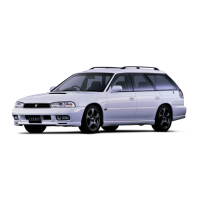


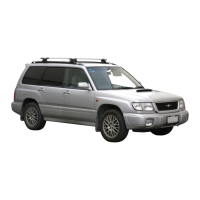
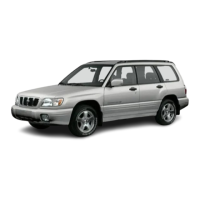

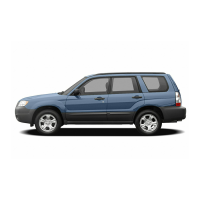
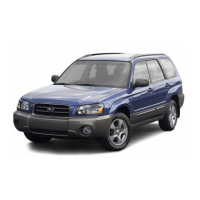
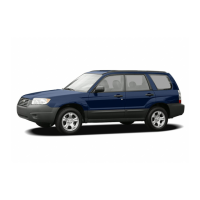



